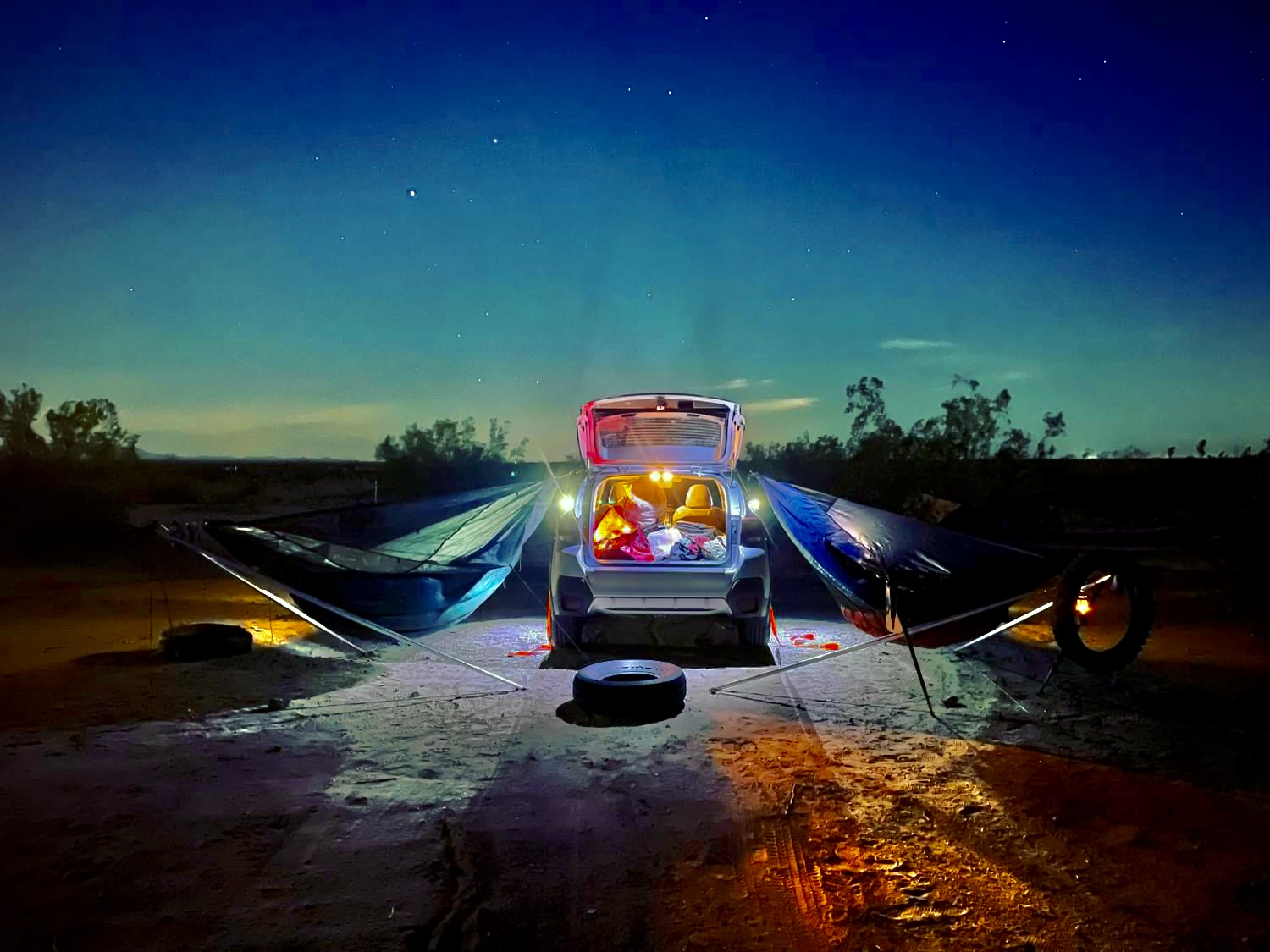
Our Tensa4 hammock stand has always been a good value, exceptionally adaptable, accommodating more hammock types and sizes, lighter, and with a smaller footprint and packed size than others.
With the February 2025 release of our seventh production series (P7) and the addition of our Freestanding mod, Tensa4 becomes even more versatile. Now you can hang up to six hammocks with just a few extra components. I made a rambling YouTube a few days ago excitedly sketching possibilities of our newest pole tip design, that has produced many email queries for clarification. This post elaborates. To help understand the drawings below, orange are lines in tension, while gray are poles in compression.
One hammock, one guyline
This is the classic Tensa4 configuration, working with:
- Gathered-end hammocks up to 12′ long
- Bridge hammocks like Warbonnet Ridgerunner
- Transverse hammocks like Amok Draumr
- “Lay-flat” designs like Haven Tents
It works even on steep slopes, often available when all flat spots are occupied. Just point the head end upslope to level the two feet. While only one guyline is required, you should guy both ends for most stability.
One hammock, freestanding
With our Freestanding mod, Tensa4 now hangs gathered-end hammocks in the smallest of spaces, able to fit a 12′ hammock in a 7′ x 9′ room, no guylines required.


The ultra-stable tripod base adds little width beyond that of the hammock itself, pointy ends allowing placement in corners, to use the longer diagonal measure of a room. Note how the higher foot end can float over obstructions like a hotel room bed.
Two hammocks, one support
Use two of Tensa4’s four poles to hang the head end of a hammock in split mode, with the foot end hanging from a tree, pole, or vehicle. My drawing’s perspective is poor, but compare with the photo, matching the important elements to understand how it works.


- No extra parts are needed for the first hammock.
- Use two extra Tensa Toggle Loops for the second hammock
- Use your regular hammock suspension for the foot ends.
Cheryl and I made a quick video explaining split mode setup procedure.
Two hammocks, no other supports
Starting with P7 of Tensa4, whose poles now allow loading while partially collapsed, all four can work as monopod stands, like our Tensa Solo. Simply collapse a 7-segment Tensa4 pole to 5 segments long. The top segment becomes the tarp extension.
Tensa4 includes everything needed for a one-pole setup. Each additional pole requires two more guylines and anchors, which we sell a la carte. Your existing tree suspension can also work as guylines.
(True Tensa Solo poles, whether bought ready made or from our Tensa4 to Tensa Solo conversion kit, weigh almost a pound less, and pack in half the space as Tensa4 poles, so they remain a better choice when that matters most.)
Three hammocks, one support
Mix and match the split and monopod modes for more hammocks. Split stands require only one stake, and have a smaller footprint than the monopods, making the splits preferable when feasible.

This requires three extra anchors and guylines plus one extra toggle loop beyond what comes with Tensa4.
Four hammocks, one support
Oh yes.

This takes six additional guylines and anchors beyond the base Tensa4 kit. You can pitch tarps, but with 16 tarp guylines plus 8 for the poles, things can get busy!
5-6 hammocks, 1-2 supports
Are we getting a bit contrived? Also yes. But, if you’ve got the Freestanding mod, you could repurpose its 9-segment ridgepole to make 1-2 more monopods, to hang the better part of a Scouting troop, a complete lesson in physics and resourcefulness. We leave to you what this looks like, and how many extra bits you’d need.
A comfy chair
Poles and ropes came before the wheel, and maybe fire, in human ingenuity. Cheryl made herself a hanging chair mount in a few moments at Joshua Tree National Park, where it is not permitted to hang from rocks. The same approach would make a field dressing hoist for game, just as quick.

Be prepared
Tensa4 is growing into the LEGO® or Erector Set® of hammock stands, letting you hang your whole crew from a compact bundle. Just like those kits of parts, we can’t provide step-by-step instructions for every possible setup, since these will vary with your hammocks, tarps, site conditions, and indeed your imagination. You should practice before relying on any of these setups.















